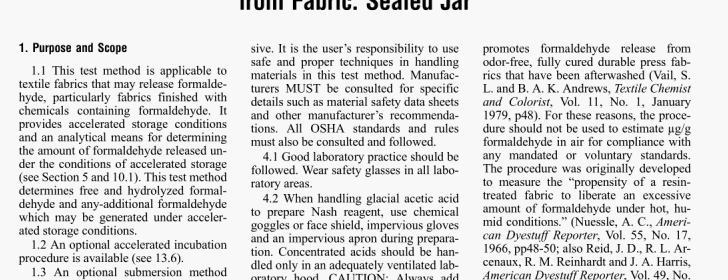Test Method for Formaldehyde Release from Fabric: Sealed Jar

AATCC 112-2020 pdf free.Test Method for Formaldehyde Release from Fabric: Sealed Jar.
NOTE: These safety precautions are for information purposes only. The precautions are ancillary to the testing procedures and are not intended to be all inclu sie. It is the user’s responsibility to use safe and proper techniques in handling materials in this test method Manufacturers MUST be consulted for specific details such as material safety data sheets and other manufacturer’s recommendations. All OSHA standards and rules must also be consulted and followed.
4.1 Good laboratoiy practice should be followed. Wear safety glasses in all laboratory areas.
4.2 When handling glacial acetic acid to prepare Nash reagent. use chemical goggles or face shield, impervious gloves and an impervious apron during preparation. Concentrated acids should be handled only in an adequately ventilated laboratory hood. CAUTION: Always add acid to water.
4.3 Formaldehyde is a sensory irritant and potential sensitizer. its chronic toxicity has not been fully established. Use in an adequately ventilated laboratory hood. Avoid inhalation or skiti contact. Use chemical goggles or face shield. impen’ious gloves and an impervious apron when working with formaldehyde (see
K. 1).
4.4 An eycwash’saiety shower should be located nearby and a self-contained breathing apparatus should be readily available for emergency use.
4.5 Exposure to chemicals used in this procedure must be controlled at or below leveLs set by governmental authorities (e.g.. Occupational Safety and Health Administration’s [OSHA1 permissible exposure limits [PEL] as found in 29 (‘FR l9lO.lO(X) see web site:
www.osha.gov for latest version). In addition. the American Conference of Governmental Industrial I lygienists (ACGIII) Threshold Limit Values (TLVs) comprised of time weighted averages (TLVTW4). short temi exposure limits (TINSTEL) and ceiling limits (TLV-C) are recommended as a general guide for air contaminant exposure which should he met (see 13.7).
5.1 The procedure is intended for use in the range of releasable formaldehyde on hydrophobic and non-hydrophobic fabrics up to about 3500 ug/g. The upper limits are 500 μg/g ifa 1:1 ratio of Nash reagent to sample solution is used in the analytical portion of the test and 3500 μg/g ifa 10:1 ratio is used. The procedure promotes ftwmaldehyde release from odor.free. ftilly cured durable press flubrics that have been afierwashed (Vail. S. L. and B. A. K. Andrews, Textile chemist and Colorist. Vol. ii. No. I. Januaiy 1979, p4X). For these reasons, the procedure should not be used to estimate jgg formaldchydc in air for compliance with any mandated or voluntary standards. The procedure was originally developed to measure the “propensity of a resin- treated fabric to liberate an excessive amount of tbnnaldehyde under hot, humid conditions.” (Nucsslc, A. C., An,erican Ovestuff Reporter, Vol. 55, No. 17, 1966. pp4-5O: also Reid, J. D.. R. L. Arccnaux. R. M. Rcinhardt and J. A. Harris. American I)vextuff Repiuler, Vol. 49. No. 14. 1960, pp29-34.)
5.2 Alternatively. Test Method 206, Free and I lydrolyzed Formaldehyde. Determination of: Watcr Extract,on Method detenuines free and hydrolyzed formaldehyde on the tubric from 20 ig1g up to about 3500 tg’g. This method approximates hydrolyzed formaldehyde and closely simulates normal user conditions. The appropriate test should be based on that distinction. However, since TM 206 is an aqueous immersion mcthod. fabrics with a propensity for dye bleeding could be of concern; if the dye has an absorbance in the range of 412 nm, it could interfere with the spectrophotometer milcasurelnent. TM 112 does not use aqUeOUS immersion; therefore there is less chance for dye contamination interfering with the spectrophotometer measurement.
6. Apparatus and Materials
6. I Clear glass jars. Mason or equivalent can fling jars. 0.95 L (I qt) and gas sealing caps. These are clear, square glass jars with approximate dimensions of 9 cm wide x 17 cm tall, contain approximately 11. and have a screw on lid.AATCC 112 pdf download.Test Method for Formaldehyde Release from Fabric: Sealed Jar